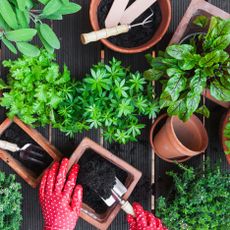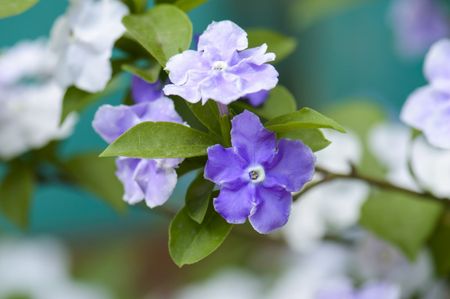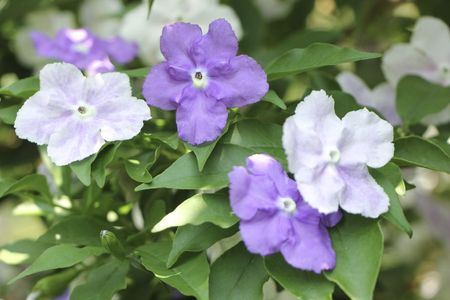Brunfelsia Shrubs: How To Grow A Yesterday, Today, Tomorrow Plant


The aptly named yesterday, today, tomorrow shrub (Brunfelsia spp.) produces a fascinating display of flowers from spring until the end of summer. The flowers start out purple and gradually fade to lavender and then white. The shrub also has delightfully fragrant flowers of all three colors throughout its blooming season. Find out how to grow a yesterday, today, and tomorrow plant here.
Yesterday, Today, Tomorrow Planting Instructions
Yesterday, today, and tomorrow plant care is easy when the shrub is grown in warm, nearly frost-free climates of USDA plant hardiness zones 9 through 12. In cooler climates, grow the shrub in a container and bring it indoors once frost threatens
. Yesterday, today, and tomorrow shrubs sustain leaf and twig damage when exposed to freezing temperatures. Yesterday, today, tomorrow shrubs will grow in any light exposure from sun to shade, but they do best when they receive morning sun and afternoon shade or dappled sunlight all day. They aren't picky about soil type, but the planting location should be well-draining.
Plant the shrub in a hole as deep as the root mass and twice as wide. Remove the plant from its container, or if it is wrapped in burlap, remove the burlap and the wires that hold it in place. Place the plant in the hole with the soil line even with the surrounding soil. Planting the shrub deeper than the level at which it grew in its container can lead to stem rot.
Fill in the hole around the roots with soil, pushing down on the soil as you go to remove any air pockets. When the hole is half full, fill it with water and wait for it to drain. Fill the hole to the top with soil and water deeply to saturate the root zone. Do not fertilize at planting time.
Yesterday, Today, Tomorrow Plant Care
As part of your yesterday, today, and tomorrow plant care, water the shrub during dry spells to keep the soil from completely drying out and fertilize once a year in spring. Yesterday, today, and tomorrow shrubs grow 7 to 10 feet (2-3 m.) tall with a spread of up to 12 feet (4 m.). Leaving them unpruned at their natural height gives them a casual appearance.
By selectively pruning out the taller stems, however, you can maintain a height as short as 4 feet (1 m.)— an ideal height for foundation plantings. These shrubs are very dense, so thinning to open up the shrub a little improves the health and appearance of the plant as well.
Gardening tips, videos, info and more delivered right to your inbox!
Sign up for the Gardening Know How newsletter today and receive a free download of our DIY eBook "Bring Your Garden Indoors: 13 DIY Projects For Fall And Winter".
Yesterday, today, and tomorrow looks great in mixed shrub borders, in foundation plantings, and as hedges. You can also try planting yesterday, today, and tomorrow away from other shrubs as a specimen plant that stays interesting throughout the year.

Jackie Carroll has written over 500 articles for Gardening Know How on a wide range of topics.
-
 What Are The Easiest Herbs To Grow From Seed? 8 Beginner-Friendly Edibles Anyone Can Grow
What Are The Easiest Herbs To Grow From Seed? 8 Beginner-Friendly Edibles Anyone Can GrowA dedicated mixed herb bed or container arrangement is a mainstay of the edible garden, but which are the easiest herbs to grow from seed? We reveal the best for beginners
By Bonnie L. Grant
-
 How Much Light Do Seedlings Really Need? And When To Use Grow Lights
How Much Light Do Seedlings Really Need? And When To Use Grow LightsYoung plants need lots of light to grow, but when started indoors, natural isn't always best. Learn seedling light requirements – and when to give them a boost.
By Teo Spengler
-
 Yesterday, Today, Tomorrow Plant Not Flowering – Getting Brunfelsia To Bloom
Yesterday, Today, Tomorrow Plant Not Flowering – Getting Brunfelsia To BloomYesterday, today and tomorrow plants have flowers that change color day by day. They begin as purple, fading to pale lavender and then to white over the next couple of days. Find out what to do when this enchanting tropical shrub fails to bloom in this article.
By Jackie Carroll
-
 Brunsfelsia Propagation – Learn How To Propagate Yesterday Today and Tomorrow
Brunsfelsia Propagation – Learn How To Propagate Yesterday Today and TomorrowBrunfelsia propagation can be done through tip cuttings taken from the current season's growth or from seeds. For information on how to propagate yesterday, today, and tomorrow plants, click this article.
By Teo Spengler